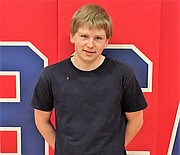Superior students receive valuable welding certificates
Kathleen Woodford Mineral Independent | Hagadone News Network | UPDATED 8 years, 6 months AGO
The demand for welders is putting a spark in the U.S. job market due to increased construction and because within five years 25 percent of the skilled welders will be retiring. All this with a welder’s earning potential matching those of a mid-level executive of a Fortune 500 company. That’s why students in Superior’s welding class were excited and nervous for the opportunity to take national tests for welding certification.
“The awesome thing about this certification is that some kids who were certified right out of high school got hired right away making $96 per hour,” said welding teacher, Jeff Shultz. “At Tricon (a lumber mill near St. Regis) they don’t have anyone in their welding staff who is certified. If you get certified it’s an automatic dollar raise. You can make some serious money doing welding where $40 an hour is not an uncommon wage.”
The Superior students took Welding 1 all year long and then practiced for a week and a half for the full-day of testing. The tests were held a few weeks ago by Roddy Martel from Flathead Community College, who travels around Montana administering the tests.
Seven high school students took the test where three failed and four passed. The four that passed were freshman, Kyler Francis; junior, Connor Voll; freshman, Raine Kaufman and freshman, Howard Edison.
The certification was for a G1 SMAW Operation (Shielded Metal Arc Welding). A process that welds by heat from an electric arc, between a flux-covered metal electrode and the work. Shultz showed the work the students did which was two pieces of metal welded together and bent.
Both Francis and Voll said they were nervous taking the test which involved several passes over the metal with grinding and cutting. They said they messed up the passes by going too fast or doing the zig zags too high which left holes which causes the flux core to be weak. But in the end, they passed and now hold a certificate which is good for a lifetime. However, due to liability concerns they cannot be hired until the age of 18.
“It’s a cool thing that we can get these students certified in high school. It’s something they can leave with,” said Shultz. “This is a great opportunity, especially for the kids who aren’t going to go to college. We want to get them as marketable as possible. There’s a huge demand for skilled labor in today’s market with the skilled baby boomers leaving the workforce as they retire.”
In the future, Shultz would like to work with Tricon to get students OSHA (Occupational Safety and Health Administration) Certified. Which is a 40 hour class that will make students even more hirable.
This is his first year teaching welding and next year students will be able to get dual credit for the courses for both high school and college. Then, depending on the college they attend, the class will transfer and go towards their degree. Two courses are offered, Welding I and Welding 2, and both could earn students certifications. Shultz would also like to give the Alberton welding students the opportunity to take the certification tests next year when Martel comes to Superior.
Francis said that working with the welding equipment was scary at first because he had never done it before but then it got easier. Overall both he and Voll liked working with the gases, heat and didn’t mind the dangers that come along with the job.
Welders are prone to more injuries than the average occupation. They are exposed to a number of hazards such as exposure to direct heat and intense light. Due to these dangers they wear a number of protective gear such as heat-resistant gloves, goggles, masks and other equipment.
“Sometimes you get burns on your hands or it may chip off and hit your neck or catch your hair on fire,” said Voll, who is looking at going to college in Dillon when he graduates next year.
Francis has several more years to decide what his career choice will be but said his dad was once a welder and said it was a good field to get into. If Francis and Voll pursue a career in welding they both expressed an interest in working in the oil fields.
Shultz said he has a friend who does underwater welding and makes upwards of $125 per hour. He works for a company that sends him out to jobs and in February he went to Hawaii for a week and the job paid all of his expenses.
According to the US Department of Labor Hawaii is one of the top paying states for welding at a median wage of $59,120. Alaska’s median wage is $71,910; Wyoming at $52,980; North Dakota at $50,310; and Delaware at $47,820. In Montana the median wage is $38,940 or $18.72 per hour. The Labor Department also reports that between 2014 and 2024 there will be 145,600 annual job openings nationally in this field.
Most welders work in the manufacturing industry where 61% of them are employed, 11 percent work in construction, and 5 percent in wholesale trade and other industries. Top industries include electric power generation with an annual mean wage of $69,120; natural gas distribution at $68,420; transportation of crude oil at $61,980; postal service at $57,990; and artificial synthetic fibers and filaments manufacturing at $57,990.
ARTICLES BY KATHLEEN WOODFORD MINERAL INDEPENDENT
Mineral County sends tax bill to Forest Service
The Forest Service will be receiving a property tax bill from Mineral County this year. County Commissioners Laurie Johnston, Roman Zylawy and Duane Simons signed the letter March 9 requesting property tax revenue for 2017. The “historic letter” as defined by Rep. Denley Loge, describes the plight Mineral County is facing as options to fund the county have dried up.
Colorado woman dies after vehicle gets stuck
An early evening call received by Mineral County dispatch on Friday, March 17, ended in tragedy. The body of Colorado resident Debra Ann Koziel was found in the Fish Creek area by a search team the following Tuesday afternoon. Her death was determined to be the result of exposure to weather.

No major flooding as snow thaws
“As the ground starts thawing, the rocks start falling,” was a post made on the Mineral County Sheriff’s Office’s Facebook page last week. A photo accompanied the post of a big rock which had come down on Mullan Road East near the Big Eddy fishing access in Superior on March 11. “Please be aware of your surroundings and pay attention while driving,” they warned in the post.







